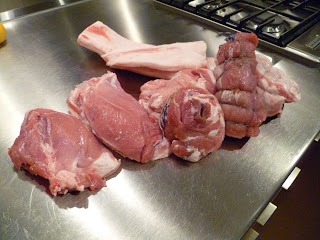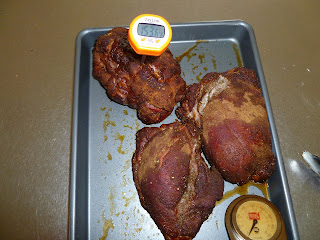
 |
| Pork Shoulder tossed with spices |
 |
| Grinder and Seasoned Pork in Freezer |
Next I placed the pork in the fridge and mixed up the spices. I tossed the pork and then I placed it in freezer to lower the temperature before grinding. I like to grind when the meat is around 35 degrees. While the meat was cooling, I prepared for the grinding process. I wiped everything down with a bleach/water mixture. Then I placed the metal mixer bowl in a bowl of ice.
 Time to grind the meat....I ground the breakfast sausage first. Cleaned the blade and plate, then started on the Chorizo. A few..... minutes or more later. I had a nice bowl of ground sausage. I added the tequila and red wine vinegar and emsulfied the sausage. Cathy - thanks for the tip to use a plastic bag to force all the meat through the grinder. It works great!
Time to grind the meat....I ground the breakfast sausage first. Cleaned the blade and plate, then started on the Chorizo. A few..... minutes or more later. I had a nice bowl of ground sausage. I added the tequila and red wine vinegar and emsulfied the sausage. Cathy - thanks for the tip to use a plastic bag to force all the meat through the grinder. It works great!Next is the fun part, I put the sausage in the fridge and put a small patty in a pan to "test the seasoning". I didn't realize that I hadn't eaten lunch before I started making sausage. It was about 3:30. That patty tasted pretty good, but I needed to try it again... another patty, this time a test of the texture and fat content. And then another patty. Ummm that was a good lunch. The seasoning was spot on...
 Test sample #1 , that was followed by test sample 2 &3 |
Look! the right amount of fat, browns nicely and the texture is firm. I decided to go ahead and fill some casings. I stuffed about half the sausage and shaped the other half into couple logs.
The next day I smoke the sausage in the Bradley. I must say the Bradley is working great. No more wasted
bisquettes. I have used it for spare ribs that were smoked with a spicy dry rub. The ribs were juicy and tender. I also smoked some country style ribs that I used in a Pork Mole and the next day was mixed with pinto beans. I PIGGED out.
I don't have a recipe or pictures of my first meal with the loose Chorizo. My plan was a stacked enchilada with cheese, chorizo and scrambled eggs. The tortilla was tough and it didn't work very well.
The breakfast sausage: I found that the garlic and sage over powered the sausage for breakfast. I was reading a Bon Appetit article on the best way to cook pasta... So I invented a new pasta dish using the breakfast sausage. Playing off the stronger garlic and sage flavor, I paired it with butternut squash and whole wheat spaghetti in an alfredo type sauce. It had the flavors of gnochhi and squash, with a twist of meat. Here is the recipe.
Oinkjoint Sausage and Butternut Squash Spaghetti
11/2 cup butternut squash, peeled and 1/2" dice
1 lb sage and garlic breakfast sausage
Cook spaghetti for four people to just before al dente
Cream and reserved pasta water
Grated Pecorino Romano
Saute the squash in vegetable oil until tender and browned. Remove from pan. Add small amount of oil and break sausage in the pan. Add fresh ground pepper. When browned, return squash to the pan. Deglaze the pan with a splash of chicken stock. Add enough whipping cream to cover the bottom of the pan. Add a handful of Pecorino. When heated and cheese is incorporated, add the almost al dente spaghetti to the saute pan. Toss to coat. Add 1/2 cup hot pasta water to pan and continue tossing pasta. Add more pasta water if needed. Cook until pasta is al dente and nicely coated with sauce. Garnish with more Pecorino.
This met my expectations of sage, squash, pasta in a creamy sauce. The sausage took it over the top.
After writing this post, I had to try the chorizo again. I browned some diced potatoes and onions in oil. I sliced a couple links of the smoked chorizo, and added them to the pan. Added some chicken stock, let the dish simmer until the potatoes were soft and the sauce had thickened. I served the dish with a fried egg. It was yummy. The sausage seasoned the potatoes and gave the dish a real kick. I am really please with my work this month... practice makes it better!




































